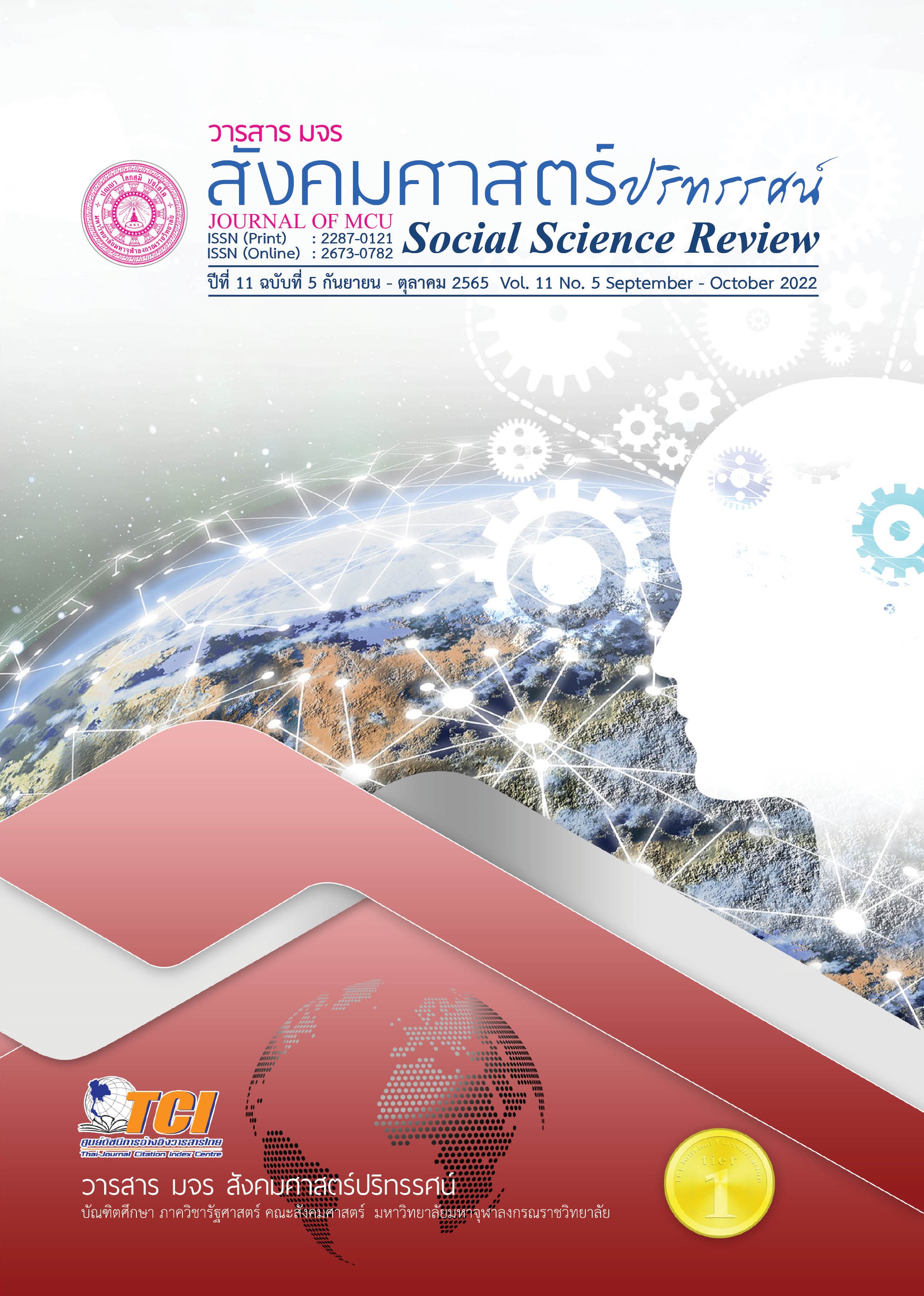การศึกษาเปรียบเทียบกระบวนการลงนิคหกรรมตามกฎมหาเถรสมาคม ฉบับที่ 11 (พ.ศ. 2521) กับประมวลกฎหมายวิธีพิจารณาความอาญา ศึกษากรณี: วิธีการไต่สวนมูลฟ้อง
คำสำคัญ:
กระบวนการลงนิคหกรรม, ประมวลกฎหมาย, วิธีการไต่สวนมูลฟ้องบทคัดย่อ
บทความนี้มีวัตถุประสงค์ 1. เพื่อศึกษาการวิเคราะห์เปรียบเทียบกระบวนการลงนิคหกรรมตามกฎมหาเถรสมาคม ฉบับที่ 11 กับประมวลกฎหมายวิธีพิจารณาความอาญา 2. เพื่อศึกษาวิธีการไต่สวนมูลฟ้องตามกระบวนการลงนิคหกรรมตามกฎมหาเถรสมาคม ฉบับที่ 11 (พ.ศ. 2521) ศึกษาค้นคว้าเอกสาร เก็บรวบรวมข้อมูลจากเอกสารที่เป็นผลงานทางวิชาการ ต่างๆ วิธีการวิเคราะห์ข้อมูลเชิงพรรณนา และบรรยายเชิงพรรณนาสอดคล้องกับวัตถุประสงค์
ผลการวิจัยพบว่า 1. การวิเคราะห์เปรียบเทียบกระบวนการลงนิคหกรรม คือ การดำเนินคดีอาญาในชั้นศาลจะต้องมีโจทก์เป็นคู่ความฝ่ายหนึ่ง คู่ความฝ่ายที่มีอำนาจฟ้องคดีอาญาต่อศาล เนื่องจากการกระทำในคดีอาญานั้นเป็นเรื่องที่กระทบกระเทือนต่อความสงบเรียบร้อยของประเทศ ผู้เสียหายมีสิทธิที่จะฟ้องคดีอาญาได้ด้วยตนเอง 2. วิธีการไต่สวนมูลฟ้องตามกระบวนการลงนิคหกรรม เปรียบเทียบวิธีไต่สวนมูลฟ้องตามประมวลกฎหมายวิธพิจารณาความ ได้กำหนดวิธีปฏิบัติไว้ดังนี้ ถ้าฟ้องถูกต้องตามกฎหมายแล้ว ให้ศาลจัดการสั่งต่อไปนี้ 1) คดีราษฎรเป็นโจทก์ ให้ไต่สวนมูลฟ้อง แต่ถ้าคดีนั้นพนักงานอัยการได้ฟ้องจําเลยโดยข้อหาอย่างเดียวกัน ให้จัดการตามอนุมาตรา (2) 2) คดีพนักงานอัยการเป็นโจทก์ ไม่จำเป็นต้องไต่สวนมูลฟ้อง แต่ถ้าเห็นสมควรจะสั่งให้ไต่สวนมูลฟ้องก่อนก็ได้
เอกสารอ้างอิง
กรมการศาสนา. (2542). หนังสือคู่มือพระสังฆาธิการว่าด้วยพระราชบัญญัติ กฎ ระเบียบ และคำสั่งของคณะสงฆ์. กรุงเทพฯ: โรงพิมพ์การศาสนา.
คณิต ณ นคร. (2549). กฎหมายวิธีพิจารณาความอาญา. กรุงเทพฯ: บริษัท โรงพิมพ์เดือนตุลาจำกัด.
________. (2549). ประมวลกฎหมายวิธีพิจารณาความอาญา หลักกฎหมายและพื้นฐานการเข้าใจ (พิมพ์ครั้ง ที่ 3). กรุงเทพฯ: สำนักพิมพ์วิญญูชน. 2560.
คนึง ฤาไชย. (2520). กฎหมายวิธีพิจารณาความอาญา 2. กรุงเทพฯ: โรงพิมพ์มหาวิทยาลัยรามคำแหง.
นคร พจนวรพงษ์ และพลประสิทธิ์ ฤทธ์รักษา. (2535). ประมวลกฎหมายแพ่งและพาณิชย์. ฉบับแก้ไขเพิ่มเติมใหม่. กรุงเทพฯ: เจริญกิจ.
พระธรรมดิลก (ปุณฺณสิริ). (2492). ประมวลอาณัติคณะสงฆ์. กรุงเทพฯ: โรงพิมพ์อักษรเจริญทัศน์.
มหาจุฬาลงกรณราชวิทยาลัย. (2539). พระไตรปิฎกภาษาไทย ฉบับมหาจุฬาลงกรณราชวิทยาลัย. กรุงเทพฯ: โรงพิมพ์มหาจุฬาลงกรณราชวิทยาลัย.
สัญญา ธรรมศักดิ์. (2535). คำอธิบายประมวลกฎหมายวิธีพิจารณาความอาญา ภาค 1 ถึง ภาค 3 มาตรา 1-171. กรุงเทพฯ: กรุงสยามการพิมพ์.
สำนักงานพระพุทธศาสนาแห่งชาติ. กฎมหาเถรสมาคม ฉบับที่ 11 (พ.ศ. 2521) ว่าด้วยการลงนิคหกรรม พร้อมด้วยคำแนะนำแบบสำหรับใช้ในการพิจารณาวินิจฉัยการลงนิคหกรรม. กรุงเทพฯ: โรงพิมพ์การศาสนา.
ดาวน์โหลด
เผยแพร่แล้ว
รูปแบบการอ้างอิง
ฉบับ
ประเภทบทความ
สัญญาอนุญาต
ลิขสิทธิ์ (c) 2022 วารสาร มจร สังคมศาสตร์ปริทรรศน์

อนุญาตภายใต้เงื่อนไข Creative Commons Attribution-NonCommercial-NoDerivatives 4.0 International License.
เพื่อให้เป็นไปตามกฎหมายลิขสิทธิ์ ผู้นิพนธ์ทุกท่านต้องลงลายมือชื่อในแบบฟอร์มใบมอบลิขสิทธิ์บทความให้แก่วารสารฯ พร้อมกับบทความต้นฉบับที่ได้แก้ไขครั้งสุดท้าย นอกจากนี้ ผู้นิพนธ์ทุกท่านต้องยืนยันว่าบทความต้นฉบับที่ส่งมาตีพิมพ์นั้น ได้ส่งมาตีพิมพ์เฉพาะในวารสาร มจร สังคมศาสตร์ปริทรรศน์ เพียงแห่งเดียวเท่านั้น หากมีการใช้ภาพหรือตารางหรือเนื้อหาอื่นๆ ของผู้นิพนธ์อื่นที่ปรากฏในสิ่งตีพิมพ์อื่นมาแล้ว ผู้นิพนธ์ต้องขออนุญาตเจ้าของลิขสิทธิ์ก่อน พร้อมทั้งแสดงหนังสือที่ได้รับการยินยอมต่อบรรณาธิการ ก่อนที่บทความจะได้รับการตีพิมพ์ หากไม่เป็นไปตามข้อกำหนดเบื้องต้น ทางวารสารจะถอดบทความของท่านออกโดยไม่มีข้อยกเว้นใดๆ ทั้งสิ้น





